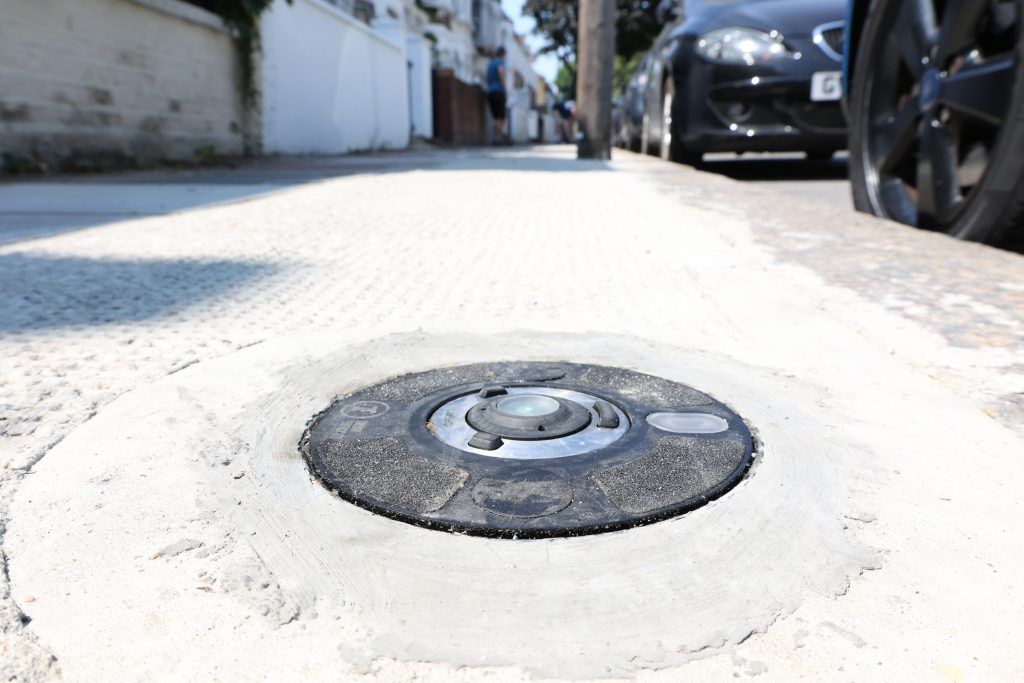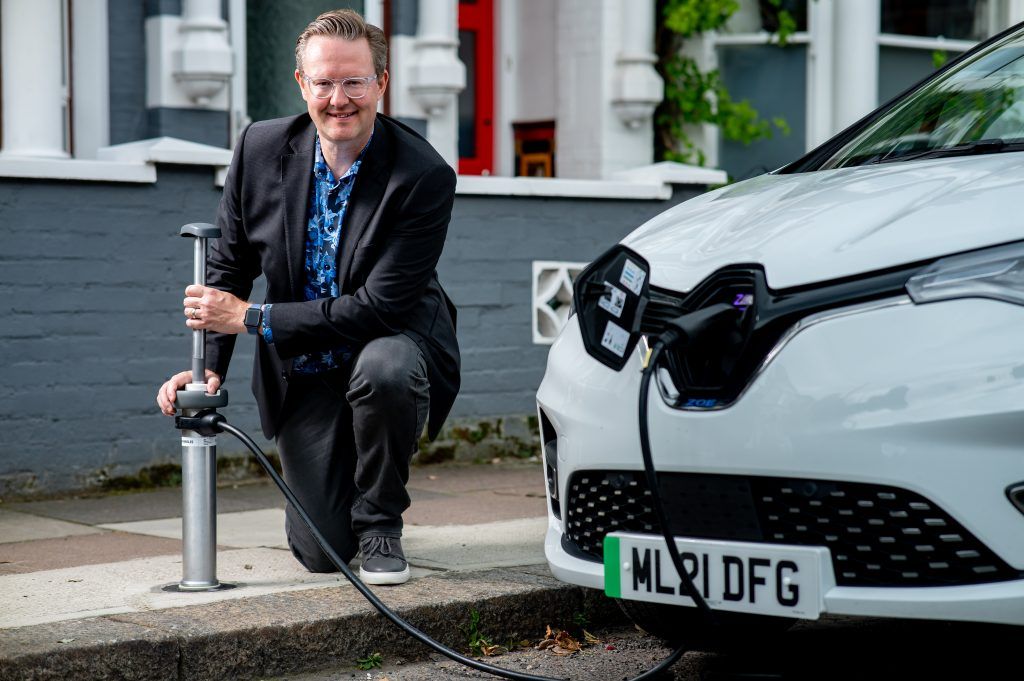Mark Constable, Head of Business Development at Trojan Energy, talks to Transport + Energy about the importance of both sectors working together and offers advice on how this can be achieved. In a wide ranging interview Mark also discusses the challenges faced by councils when it comes to the adoption of electric vehicle (EV) charging infrastructure, the Transport Decarbonisation Plan, and the types of solutions that can accelerate change.
Q. Who are Trojan Energy and what do you do?
A. “Trojan was formed by former oil and gas industry engineering executives who wanted to accelerate the energy transition and make sure everyone benefits from it. It’s the mission that also drives everyone that’s joined the company since. Our first solution is a fully future proofed electric vehicle charging system for the residential on-street market that can take the form of a hub of 15 points powered directly from the local electricity network, or a single point connected to a domestic property. The solution leaves no residual street furniture. The chargepoints themselves are fitted flat and flush to the pavement, as close to the kerb as is allowed, and are accessed via a user’s ‘lance’ – a robust post that they themselves insert which is locked in place only while charging takes place. We aim to give a virtual driveway to drivers who don’t have a physical one.”

Q. Why is it so important for both the transport and energy sectors to work together and how can this be achieved?
A. “Early on, there wasn’t actually a lot of crossover expertise between the decarbonisation disciplines. Ten years ago one was either an energy professional throwing themselves into transport (like myself) or vice versa. This was totally at odds with liquid fuelled transport, where there was a lot of crossover in knowledge that had been collectively built up over decades in long-established oil/automotive organisations. This state of affairs led to seamless integration of energy and transport to the extent that end-users didn’t really think about the energy, and we must reach this outcome again. The challenge is that along the way knowledge can’t just be incrementally built. Some things have to be unlearned and a few current orthodoxies scrapped.
“The way I think of it is that transport is simply converting one type of energy to another, while moving people around to meet their needs. Historically, it has been very effective. What it now needs to be is effective *and* clean.”
Q. What do both sectors need to be better at in order to accelerate the shift towards decarbonised transport and energy?
A. “There are so many organisations that are actively trying to bridge the divide now compared to when I started in EVs a decade ago, that are not rooted in energy, nor transport, but *people* and their needs. Trojan is one such organisation, among many many others. Incumbency can be a barrier to innovation. Clinging to outdated approaches and trying to bludgeon them into fitting the new challenges won’t work. But sometimes where long-established organisations in both transport and energy lack agility, they make up for it in reach. It’s imperative that all of us come together to work through the challenges in combining both sectors together to the extent that they used to be. Together, we stand a much better chance of solving decarbonisation and air quality.

Q. What are the biggest challenges facing local authorities in the electric vehicle space?
A. “Around 30% of vehicles in the UK are parked kerbside and this rises to over 50% in our towns and cities. Many local authorities are beginning to recieve multiple requests from residents for charging points in their areas, and this pressure on their resources will only continue to grow. However, authorities also need to balance the need for EV charging with the needs of other users of the pavement and so councils must find solutions that work for everyone.
“Within the local authority often the biggest challenge stems from EV infrastructure being an entirely new category of services with which to build internal familiarity and expertise: new technologies such as electrical equipment in public spaces; new rules and regulations in planning, new approaches to existing services such as parking and road maintenance; new business relationships; digital services in both the front and back offices; and a multitude of reports and strategies of which to take account. In addition local authorities also need to evaluate how to fit this new category into a strategy for climate and air quality response, including complementary services like public transport and any associated modal shift ambitions, while maintaining liveable and safe spaces for all. All of this takes time and resources which is often difficult for a local authority to provide.”
Q. What type of products and services do you offer that can help councils?
A. “In addition to the flat and flush clutter-free charging solutions themselves we have technology that flags to our users when charging bays become free, via an app – this reduces the chances of an internal combustion-engined car blocking a charger. But Trojan specifically advises against the use of Traffic Regulation Orders, and our systems are built to not require them. Not only are they costly in both financial and political terms, but it’s an approach that can’t keep pace with EV uptake in our towns and cities and we remove this headache. It’s important that we build our own expertise in the likely business models that will be of interest to councils given the different types of assistance that are available via funding and incentives and our systems have also been built on a component basis so we can plug our chargers into other management platforms. This can help keep the number of relationships down for council procurement functions.”
Q. In what ways do you work with local authorities to help them adopt a long-term strategy around EV infrastructure?
A. “Trojan is fortunate to have wide-ranging expertise in the technical expertise around all forms of EV charging, as well as people with long-term EV market experience across multiple parts of the value chain including the creation of EV infra strategies for some large and well-known organisations. We believe our solutions are very powerful in their niche, but there are many other charging segments which our solution doesn’t cover. We believe that the UK needs a collegiate approach and multiple technologies and propositions are vital in order to cover all the usage cases that exist. We therefore have the means, the motive and the opportunity to consult with councils in all aspects of electromobility, well in advance of talking about our own products. We’re happy for councils to tap into this expertise at any stage. Further down the line, once there is a broad plan to explore a Trojan solution, we take the lead in writing funding applications on behalf of councils and doing all the preparatory work to support those applications, including the physical surveys, and full project costings, while being very open about from where Trojan derives its benefit.”
Q. Are there any specific challenges around procurement and planning that councils need to be aware of?
A. “The single biggest procurement challenge is that there are no market participants that can cover the full range of what might be needed: Rapid hubs, roadside and car park posts, depot solutions, residential on street – multiple charging speeds, smart charging, V2G, etc. A unified strategy that tries to address everything at once might lead to lots of concurrent procurements or perhaps one procurement with lots of different concurrent requirements, delivered across a consortium. Either way, time is quite short with the 2030 deadline fast approaching and so the strongest outcomes will require the strongest commitments – from the very top of the organisation, both executives and councillors [terminology].”
Q. The Government’s recently published Transport Decarbonisation Plan (TDP) set out a number of goals and ambitions. Was there enough in the plan to provide the reassurance that some of your customers (the councils) are most likely seeking?
A. “As is often the case, the comprehensiveness of such a report often comes at the expense of accessibility. There is a lot for councils to think about, but the element likely to be of biggest actual assistance is the local authority toolkit. Of key importance will be how it comes to life. This needs to be more than a list of solutions, specifications and funding sources, and also should include techniques of how to arrive at the best answers for any given council and how to focus on the needs of constituents. Some advice on resource skills and organisation structure should be included, as well as plenty of case study material from those councils that are further down the path – both what’s worked, and perhaps even more importantly, what hasn’t.”
Q. Are there enough resources within local councils to properly achieve what is needed in a timely fashion and at the scale required?
A. “It’s difficult to answer that against the myriad of challenges councils find themselves facing, especially with COVID still having a large impact. I think the biggest lesson from the local authorities from across the UK that have led the way is not so much the amount of resource, but the focus that resource can bring to bear. Success seems easier to achieve if even a small amount of resource, even a single officer, can spend a majority of time on climate and air quality-led activities at the implementation level. Having a strategy formulated and communicated throughout the organisation is another strong pre-requisite.”
Images courtesy of Trojan Energy/Darren Cool.








